
| Camino de Santiago (Crossing the Pyrenees) |
We left Conques behind in its early morning mist and rain, first by bus to Rodez and then by train to Toulouse and on to Bayonne, arriving mid-afternoon. Here we booked into a hotel near the railway station, and then wandered over the bridge that crossed the Adour River to get some necessary supplies. It was also a chance to explore the old part of the town, its canals, city walls and magnificent world heritage listed cathedral. Here the sun was shining again and we seemed to have absorbed the period of bad weather in our rest and travel days. Tomorrow, we catch the bus to Saint Jean Pied de Port and continue the Chemin de Saint Jacques (or Camino de Santiago) as it traverses the Pyrenees into Spain. |
|
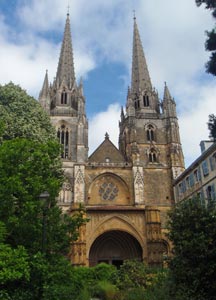 Cathedrale Sainte Marie de Bayonne .... |
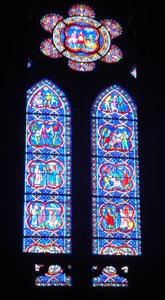 .... only 600 years to complete ... |
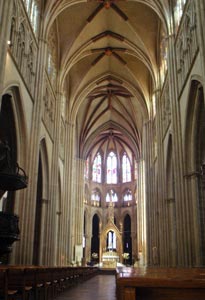 ... in all its gothic splendour |
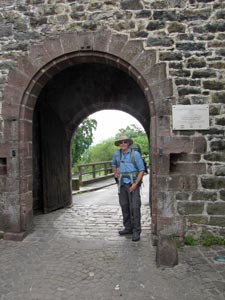 Start of the camino at the Port de St Jacques |
 The main street of St Jean Pied de Port |
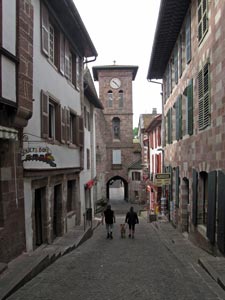 Wandering down the streets of St Jean ... |
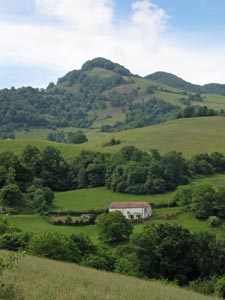 ... and out into the lush green countryside |
|
|
We wanted to enjoy the mountains, so we had booked in to the Auberge at Orisson, 8km and half of the climb away. Time to buy a baguette, some jambon cru, fromage du brebis basque and fresh strawberries for our picnic lunch, and have a slow coffee as the world passed by. It was after 11am by the time we headed off. The peloton was long gone and was already heading to the mountain tops. Apart from the odd lizard basking in the sun and a flock of kites using the thermals to soar skywards, we had the track to ourselves. Sometimes it is good to bring up the rear. |
|
|
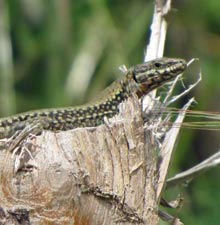 Basquing in the sun |
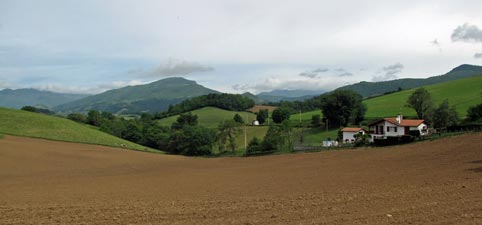 Red-brown earth, green fields, red and white houses - the colours of Basque country |
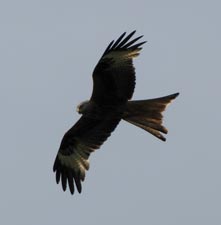 Kite on the wing |
Leaving St Jean, we picked up the Route de Napoleon, a sealed road which started with a steep sharp pinch to test your legs, before settling in to a steady climb up through the lush green hills dotted with the red-roofed white walled houses of the Basques. After a few kilometres, the ascent began in earnest, first on the road, then picking up a quiet gravel track just above Huntto. We stopped for our picnic in the shade of an old beech tree overlooking a sweeping panorama of the valley below (the Pays de Cizes), dotted with red and white houses, distant villages and framed by the rugged Pyreneen foothills. |
||
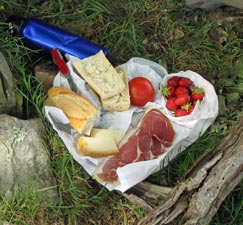 Now is that a good lunch or what!! |
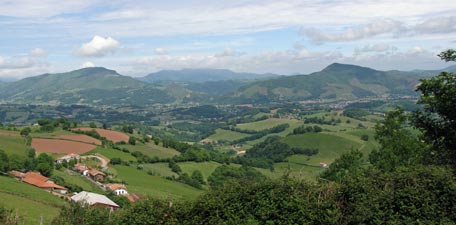 Lunchspot views over the green green valleys |
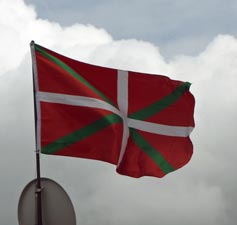 Welcome to Basque country |
|
Finally, we reached the Auberge at Orisson - tucked into the east facing slope of the ridge and looking out across the valleys and mountains beyond. It was home for the night. |
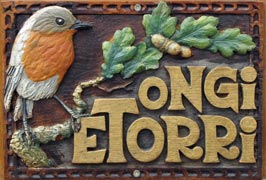 Ongi etorri - bienvenu - bienvenido - welcome! |
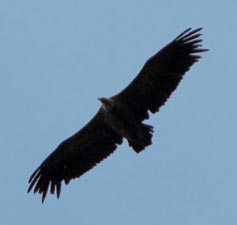 Griffon vulture soaring |
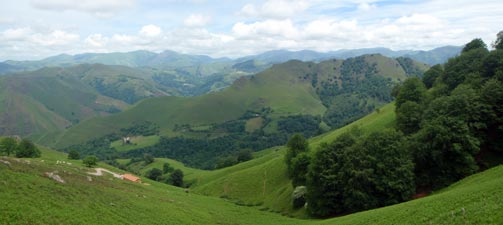 Afternoon views from the terrace of the Auberge d'Orisson |
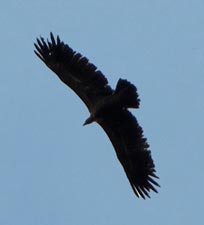 2.5m wingspan in full stretch |
The auberge terrace was a spectacular place to spend an afternoon just taking in the grandeur of the mountains, as griffon vultures soared high overhead on their 2.5m wingspan. This is a good way to start the Camino - it reinforces the spiritual journey rather than the physical one of an all day hard slog up the mountain. That would be for tomorrow.
|
We had a good night's sleep after another large meal of typically Basque cuisine, getting to know our new companions on the Chemin de St Jacques. However, the morning greeted us with a dense fog that settled into the mountain valleys and wrapped around the peaks. The day starts early on this walk, with breakfast finishing at 7.30am, there was not much else to do than head off - into the Pyreneen mists. |
||
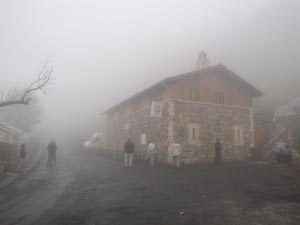 Early morning at the Auberge d'Orisson .... |
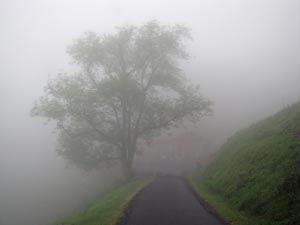 .... now where was that sun of yesterday? |
 Pilgrims in the mist |
The climb was long and steady, but not difficult, and we soon settled into a rhythm that took us up into the rounded ridge above Orisson (this we knew from a reconnoitre the night before). In reality we were walking in a bubble of visibility that rarely passed 50m, pushing steadily upwards as the mists settled out, dampening our clothes. Strange shapes passed us by in this ethereal setting - the faint outline of a tree, a grazing horse, a fellow pilgrim. Invisible nearby, a cowbell rang or a flock of sheep bleated, as we pushed up into the treeless and featureless mountain pastures. An icy wind started to blow as we reached the ridge, obliging us to don our ponchos to avoid chilling. |
||
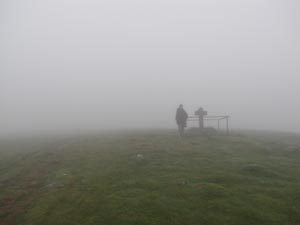 Now I think this cross is where we turn south! |
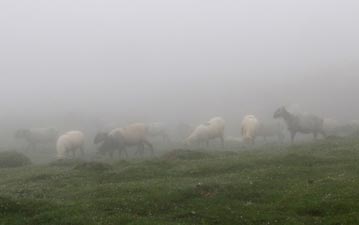 Sheep in the Pyreneen mists |
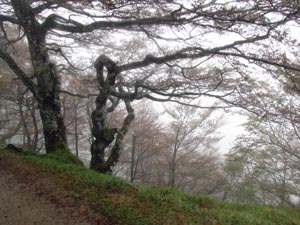 A grove of twisted beech |
|
|
Passing the Pic d'Orisson with its magnificent, but hidden, views of mountain and valley, a cross appeared out of the mist to guide us away from the road and across the pastures. The grassy track traversed a steep slope to round the Pic de Leizar Atheka. Reaching the Col de Bentartea (1340m) and the Fountain of Roland, we walked over a small cattle grid on the track. We were now in Spain - au revoir Le Chemin de St Jacques, bienvenido El Camino de Santiago! The big question was could we now retrieve the Spanish we had learnt in South America from the dark corners of our brain, to where it had been driven by a resurgent French? |
|
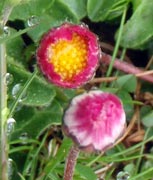 |
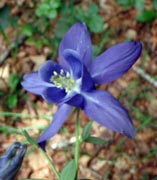 |
||
The sun tried to shine on us through the mists, but soon gave up. However, the route now descended gently through an open beech woodland - and it was a pleasure to walk for a while in the thick brown carpet of leaves beneath the mist-soften forms of the trees that lined the sheltered track. However, a change in direction brought us back out on to a featureless saddle and into the wind. |
|||
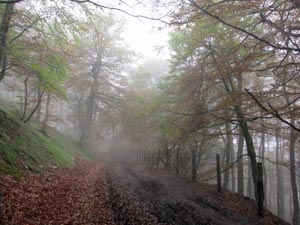 A path thick with dried beech leaves |
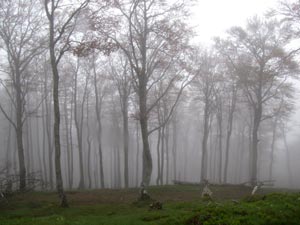 In the mists of the forest |
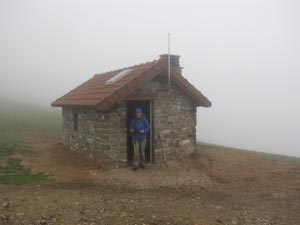 A welcome mountain refuge below the Col de Lepoeder |
We stopped to join some fellow pilgrims at a small mountain shelter to get out of the wind and have a very early lunch. Rugging up again, we set off to climb along a rough gravel track up to the Col de Lepoeder, at 1450m our high point for the day. The sun was finally making some impact and visibility was improving. By the time we started our descent, we could see out through the clouds to the valley of Roncesvalles below. |
||
|
|
|
From the col, we followed a broad dirt track steeply down through beautiful, leaf-carpeted beech forest. Higher up a late cold snap had burnt the new leaf growth to a crinkled orange - sadly beautiful. Still the trees would reshoot and soon take on the luminous green of the new beech leaves on the warmer lower slopes. |
|||
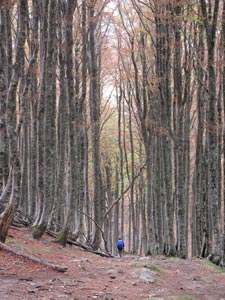 The magnificent beech forest |
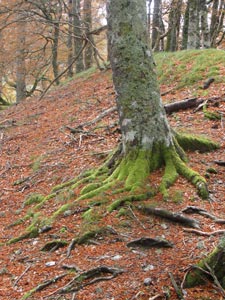 Moss-covered beech roots |
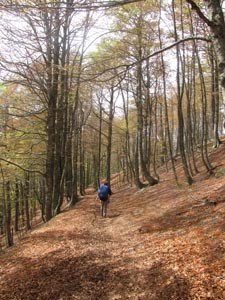 Leaf-strewn path down to Roncevalles |
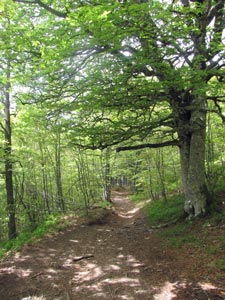 The fresh green of new beech leaves |
|
Finally we entered into the sunlight of the valley and the site of the Monastery and Collegiate Church at Roncesvalles - an important pilgrim stop since the 11th century. It is also the place of legend, immortalised in "The Song of Roland" about the heroic rearguard defence of Roland in the battle of Roncesvalles against the hordes of Saracen in 778. Truth be known, Roland was shafted by his emperor, Charlemagne who, while marching his army through their lands, broke his word to the Basques and destroyed the walls of Pamplona. Somewhat peeved, the Basques (not the Saracens) attacked Roland and his rear guard and, with tactics resembling modern guerilla warfare, completely routed them. So the moral of the story really is, don't mess with the Basques. |
|
|
 |
 |
||
|
|||
We had crossed the top of the Pyrenees and while the grand views of yesterday were missing, the dense mountain fog made for an ethereal journey. We checked into our accommodation, a 120-bed single room dormitory in one of the old monastery buildings, which promised to be an experience in itself, and spent the rest of the afternoon soaking up the sun over the odd beer or two as we watched the billowing white clouds being swept away from the mountains above. Bienvenido en Espana!! |
|||
|
|
At 6am the hospitaleros looking after our 120 bed albergue wandered down the aisles singing loud hallelujahs! It made for a different alarm clock, but the fair Nello and I decided to stay in bed a while until the morning mayhem of over 100 walkers getting up at the same time cleared. It was a bit like watching the preparation of honeybees before pouring out of hive for the days foraging. Even with our tardiness, we were up and on the road by 7am. The stiff cold wind had blown the clouds off the mountain tops and a perfect blue sky greeted us. From Roncevalles, the camino path ran parallel to the main road through the shady fringing forest to quickly reach the next town of Burguete, with its typical basque houses and welcome stop for breakfast in the sunshine with new friends from Sweden, Denmark, Italy and South Africa - such is the life of the camino. Back on the track, we headed away from the road, crossing the narrow Rio Urrobi to follow a variety of footpaths and country roads through fields and forests of Navarre to the next town of Espinal. |
|
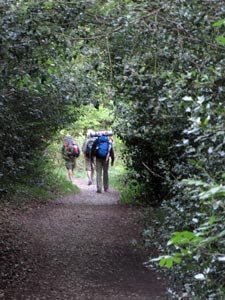 Pilgrims setting off from Roncevalles |
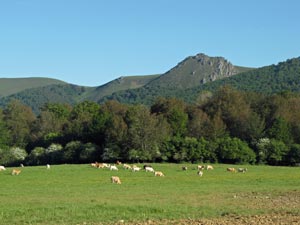 A sunny morning in the foothills of Navarre |
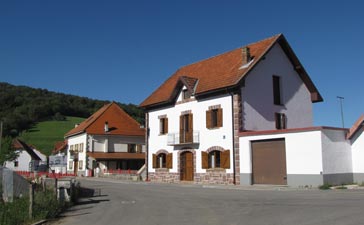 Typical basque houses in Espinal |
The Pyrenees had a very different aspect here - unlike the steep-sided, sharp-ridged mountains in France, they fell gently away like a rumpled green blanket - the walking was easy and pleasant. Espinal, however, was the start of our first climb of the day, a gravel road leading us up to the Alto de Mesquiriz with broad views over valleys to both sides and mountains beyond. |
||
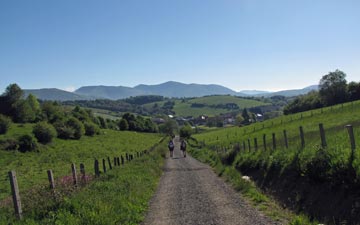 The climb out of Espinal |
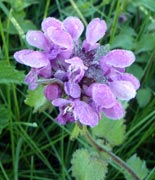 |
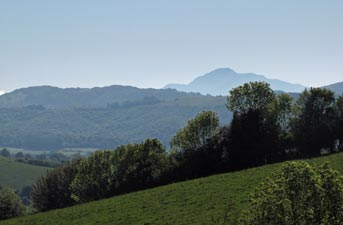 The landscape of Navarre (Alto de Mesquiriz) |
On the descent we came across the first purpose-built camino path, a broad concrete track that took us down through a forest full of songbirds to cross the Rio Erro via stepping stones and climb gently up to the old basque village of Viskarret. It was time for a coffee break and to buy our lunch supplies before heading on again. |
||||
 |
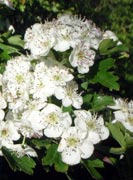 |
|
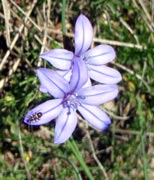 |
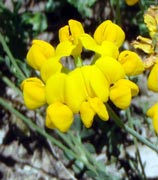 |
|
|
|||
From Viskarret, the path wandered gently up to Linzoain, with its 18th century houses, before our second and last climb of the day - sweating our way steeply up a ridge covered with sweet-smelling broom and wildflowers of many hues to reach the mixed pine-beech forest of the Alto de Erro. |
 Mixed pine and beech woodland
|
 |
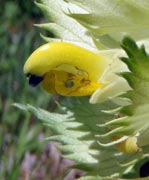 |
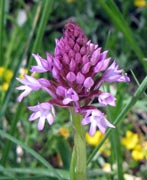 |
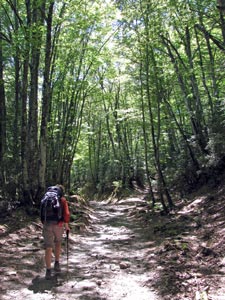 Shady path down the ridge
|
Here we wandered along a pleasant shady track that followed the ridgeline, stopping at a clearing in the forest to eat our lunch beneath the sweetly resinous scent of the pines. The day was warming up and a short siesta followed. Continuing on beneath the pleasantly shady trees, we crossed a sealed road to start a long and gradual descent along a dirt footpath that followed the long spur down to the valley of the Rio Arga. 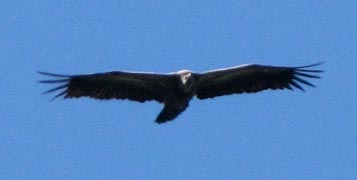 Griffon vulture soaring high |
||||
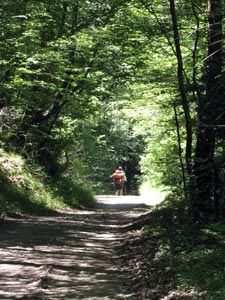 The descent to the Rio Arga |
 The countryside above Zubiri Reaching the river, we crossed the Puente de la Rabia, a medieval stone bridge purported to cure rabies (if you can get your mouth-foaming animals to cross it three times without biting you), to reach the quiet little town of Zubiri. |
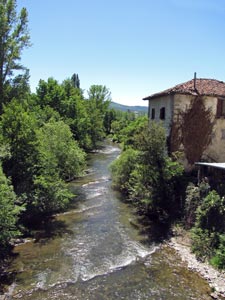 Rio Arga at Zubiri |
It was mid-afternoon and the sun shone warmly in the valley. We joined a few other pilgrims seeking out shade and a cold beer near the taverna - the locals were all still having their siesta. Our accommodation for the night was a big contrast to the monastery at Roncevalles - a small privately-run albergue, with only eight to a room and no early morning hallelujahs to wake us up - a little less ambiance but hopefully a little more sleep!
|
After the orchestral snoring performance of two Spanish pilgrims in our bunk-room, we were beginning to think that 120 people in a great big dorm was better than 8 in a small one! Still, the sky was blue and the road lay ahead. We set off a bit later, following the camino track down the valley of the Rio Arga to quickly pass the first major blot on the landscape - a large and noisy magnesite plant with associated sludge pits. Pushing on, the track led us along an undulating path, past field, forest fragment and hedgerow towards Larrasoana and its medieval bridge. The noise of the mine was replaced by the singing of birds in the hedgerows and life on the track returned to as it should be. |
|
|
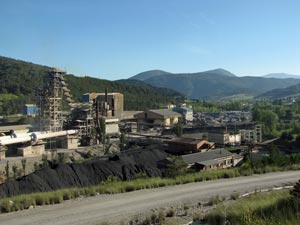 Blot on the horizon - magnesite plant near Zubiri |
|
|
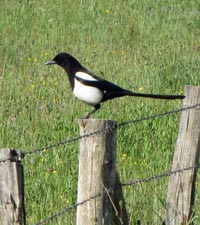 The ubiquitous European magpie |
From Larrasoana, the track continued to follow the river valley down, at times high above on the hill-slopes, at times beneath the cool dark trees lining the banks of the Arga. It was pleasant walking alongside the stream, as it either babbled its way along a stony bed or slowly flowed down still green reaches. |
|||
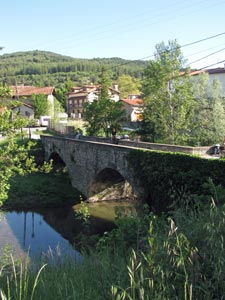 The medieval bridge at Larrasoana |
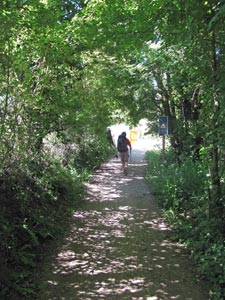 Shaded path in the valley |
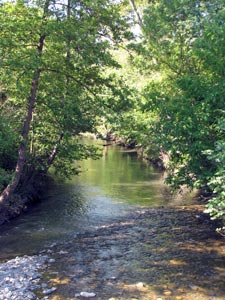 The Rio Arga |
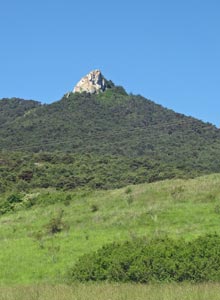 Hillside of the Arga Valley |
|
Crossing a bridge into the hamlet of Zuriain, we were brought back to reality by a short stretch of walking along the edge of a busy highway, before another bridge led us back to the peaceful east bank - time for a bite to eat on the shady bank of the stream. From here we climbed up onto a steep ledge high above the river to pass through Irotz, and descend yet again to cross the river to Zabaldica.
The sun was now getting quite warm as we climbed up and around the exposed slope of Monte Nerval, hot but subtily scented with honeysuckle, sweetbriar and broom in flower. |
|
||
|
|
|
|
|
|
The landscape was taking on a distinctly drier look as we passed beneath the highway to climb over Monte Miravalles and descend into Pamplona. It seemed a particularly fitting entry for pilgrims on the splendid medieval bridge across the Rio Ulzama. The monastery here has been taking in pilgrims since the 11th century. |
|
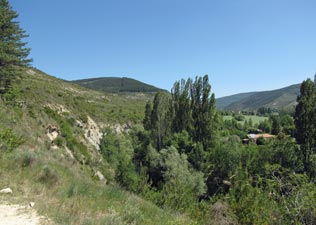 The drier landscape of Monte Nerval |
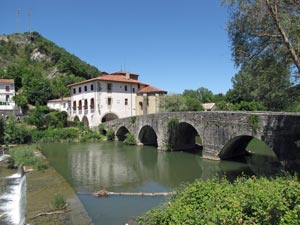 The medieval bridge over the Rio Ulzama and the Convento de la Trinidad de Arre |
|
|
From the bridge we wandered down the impeccably manicured streets of modern Pamplona, strangely quiet during the hours of siesta. A final crossing of Rio Arga on the Puente Magdalena brought us beneath the impressive stone walls of the old city. We entered via the Portal de Francia and found our way to the monastery, where we could get our creancials stamped and call an end to the second stage of our Camino experience.
|
|
|
The next day was a day off to catch up with washing, organise travel and enjoy the sights of Pamplona. We are not afficianados of big cities, but Pamplona gets our thumbs up, with its clean, broad urban landscape and many parks, centered around a vibrant old city. |
|
From listening to the magnicifent organ resonating through the cathedral to dancing with the locals at an impromptu street corner performance, or just watching the Spanish enjoy their evening strolls over a beer, there is certainly a vibrancy to Spanish urban life that is missing from home. |
|
|
|
||
The highlight though was to stroll the Encierro (the path run by the bulls during the festival of St Fermin) - down the narrow streets with rows of tiny balconies above, we ended up inside the Plaza del Toros. Who would have believed that the fair Nello and I would be standing in the middle of the Pamplona bull ring only 2m away from the bulls! OK, it was an agricultural show, they were beef stock and behind a fence, but let's not spoil a good story!
|